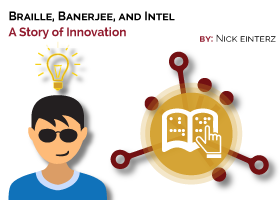Braille, Banerjee, and Intel
 Nick Einterz, Lecturer at the International English Center, University of Colorado, Boulder.
Nick Einterz, Lecturer at the International English Center, University of Colorado, Boulder.
The word “compliance” can have a negative connotation. Often, in many professions the word is a dreaded symbol of bureaucracy and additional work. Further, as content-area experts focus on innovating within their specific discipline, they do not tend to prioritize innovation for compliance issues, nor do content-area experts regularly consider it their place to do so.
Fortunately for language teachers, many do prioritize innovation for language learners, specifically in ADA compliance and the digitization of paper media. Banerjee is likely the youngest example of these forethinkers. At the age of 13, this young man innovated in a myriad of ways. First, using Legos, makeshift printing heads, original software and a paper roll, Banerjee built a braille printing machine he calls Braigo. While technically impressive, this prototype promises to be economical as well. Banerjee, in fact, disrupted the braille printing industry as the retail cost of his prototype is only $350, many times cheaper than the next least expensive braille machine. For language instructors, Banjeree’s invention could assist in teaching reading skills to the visually impaired for a fraction of the price (Worstall, 2012).
This innovation caught the attention of Intel where young Banerjee continues to improve upon his first prototype, “the Lego Braille Printer (Braigo v1.0)”. According to our interview with Banerjee, this version “was to prove if it’s possible using Legos” to inexpensively achieve basic functionality of a braille printer. Most recently, however, Banerjee’s newly founded company, Braigo Labs Inc., has worked “to launch the final version of the product in the market” which will include a “free on-chip transcription software” demoed here by Banerjee:
Interestingly, this innovation has been met with “trolls and emails” according to Banerjee. By disrupting the braille industry so dramatically, it appears plausible that some industry stalwarts would be concerned about the trajectory of traditional braille printer sales. And while Braigo Lab’s recent funding push from Intel Capital is a boon to Banerjee’s ambitions, it may further disrupt an industry apparently long in need of disruption.
In fact, the braille industry has been nobly struggling with a number of issues over the last two decades. According to Kevin Carey, chair of the Royal National Institute of Blind People in London, “the gateway to learning Braille has been operated by professionals instead of Braille being an easily accessible, mass-market product.” These professionals work to improve accessibility with the best intentions, but the economic realities of the braille industry have nonetheless become palpable. In 2012, Mr. Carey clearly saw governments’ budgetary and educational goals as problematic. He noted that “the budgetary tribulations of California” and “South Korea’s decision to phase out all paper books from its education system by 2015” indicated the challenges facing the braille industry (Carey, 2012).
Although, Braigo 2.0 will not fully mitigate the challenges facing the braille industry, it appears poised to make an impact, especially for language teachers. Banerjee hopes that an “automatic language translation chip” will be useful to foreign language and ESL learners alike. A user will be able to “type in English and choose Spanish as an output” for Braigo 2.0, which has obvious benefits for language learners. As impressive as this and other features are in Braigo 2.0, the braille industry does seem poised for even more disruption. In fact, beyond braille, the digitization of paper media into audio for virtual software may also provide both new challenges and solutions. In any case, it is worth noting how this overlooked industry moves forward. In order to do so, it will likely require more creative thinking and invention like that of Banerjee’s.
REFERENCES
Carey, Kevin. “Future Recommendations: The Democratization of Braille – Convention Report 2012.” NFB. 2012. https://nfb.org/images/nfb/publications/fr/fr31/4/fr3104tc.htm.
Worstall, Tim. “This Digital Age: Why Isn’t It A Paradise For Braille Readers?” Forbes. August 18, 2012. http://www.forbes.com/sites/timworstall/2012/08/18/this-digital-age-why-isnt-it-a-paradise-for-braille-readers/#13587b391962.

